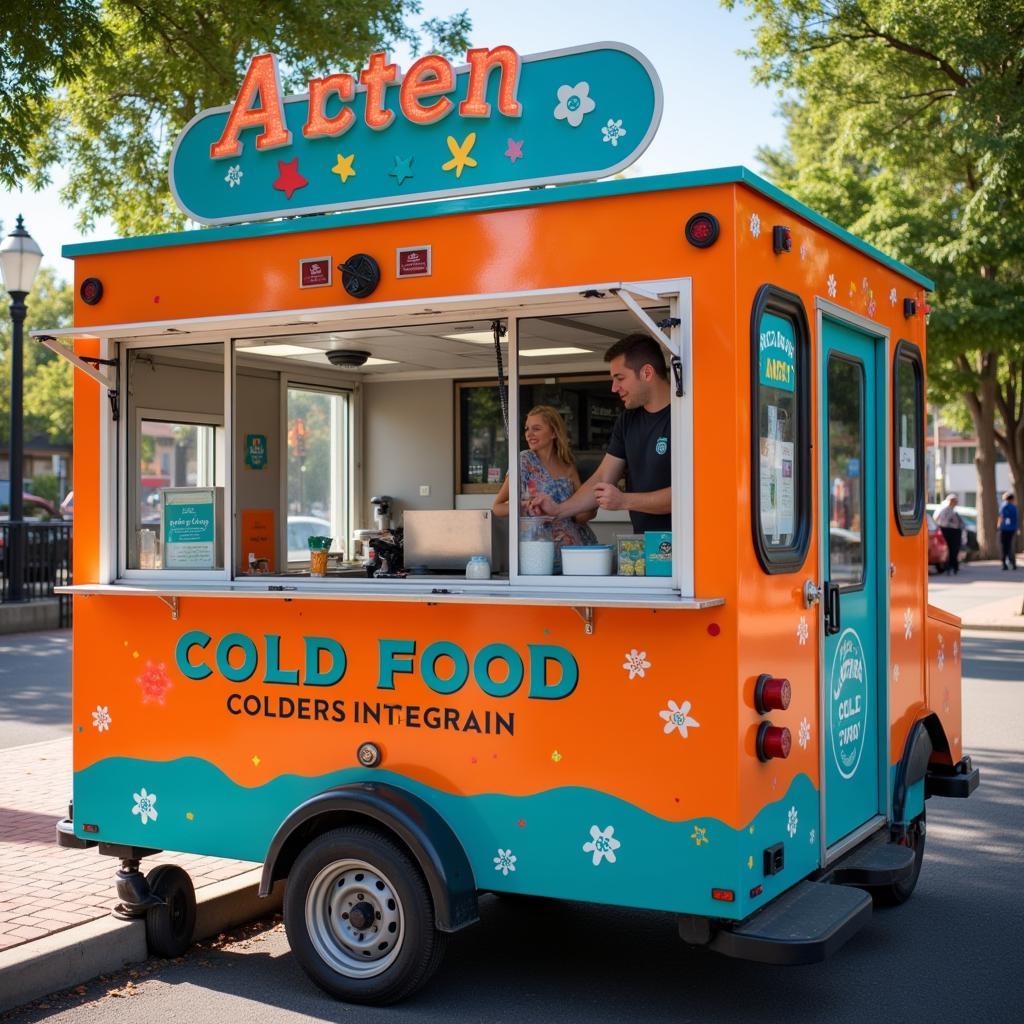Cold Food Vending offers a fantastic opportunity to tap into the ever-growing food industry, providing convenient and refreshing treats to people on the go. Whether you’re an entrepreneur seeking a new venture or an established business looking to expand, understanding the ins and outs of cold food vending can pave the way for sweet success.
What is Cold Food Vending?
Cold food vending involves selling pre-packaged food items that are stored and dispensed at safe, chilled temperatures. This business model offers a versatile range of options, from classic vending machines to mobile carts and trailers. Think beyond the soda and chips; cold food vending encompasses a diverse menu including:
- Sandwiches and Wraps: Perfect for a quick lunch or satisfying snack.
- Salads: Fresh and healthy options for the health-conscious consumer.
- Yogurt Parfaits: A delicious and nutritious breakfast or afternoon pick-me-up.
- Fruit Cups: A refreshing and vitamin-packed treat for any time of day.
- Beverages: Bottled water, juices, and sports drinks to quench thirst on the go.
The Benefits of Starting a Cold Food Vending Business
Venturing into the world of cold food vending offers a range of advantages:
- Low Startup Costs: Compared to traditional brick-and-mortar food businesses, cold food vending typically requires less initial investment.
- Flexibility and Mobility: Mobile carts and trailers allow you to target high-traffic locations and events, maximizing your reach and sales potential.
- Minimal Staffing Needs: Cold food vending can be managed with minimal staffing, reducing labor costs.
- 24/7 Revenue Stream: Vending machines offer the potential for round-the-clock sales, even while you’re not physically present.
Key Considerations for Cold Food Vending Success
To thrive in the competitive food industry, it’s crucial to plan strategically and make informed decisions:
- Target Market: Identify your ideal customer base – students, office workers, event attendees – and tailor your product selection accordingly.
- Location, Location, Location: Secure high-traffic areas with good visibility and foot traffic to attract customers. Consider factors like permits and competition.
- Quality and Variety: Offer a diverse selection of fresh, high-quality food items to cater to different tastes and dietary preferences.
- Pricing Strategy: Research your target market and competition to determine competitive yet profitable pricing for your products.
- Marketing and Branding: Create a memorable brand identity and utilize social media and local marketing to promote your business.
 Marketing Your Cold Food Vending Business
Marketing Your Cold Food Vending Business
Choosing the Right Cold Food Vending Equipment
Selecting the appropriate equipment is crucial for maintaining food safety and optimizing your operations:
- Cold food vending machine: Ideal for high-traffic, fixed locations like offices, schools, and hospitals. Choose models with adjustable shelving, energy-efficient features, and secure payment systems.
- Cold food cart: Offers flexibility and affordability, allowing you to move between locations and target events. Ensure your cart is equipped with adequate storage, a reliable cooling system, and an eye-catching design.
- Food Trailer with Food Trailer Windows: Provides more space and professional setup for larger-scale operations. Look for trailers with ample refrigeration, serving windows, and customizable branding options.
- Electric hot box food warmer: Although focused on cold food, offering a few hot options can broaden your customer base. Invest in a reliable warmer to keep items at safe serving temperatures.
Ensuring Food Safety and Compliance
Maintaining the highest standards of food safety is non-negotiable. Adhere to these essential practices:
- Obtain Necessary Permits and Licenses: Research and comply with all local health and safety regulations for food handling and vending.
- Temperature Control: Invest in reliable refrigeration equipment and regularly monitor temperatures to prevent bacterial growth.
- Proper Food Handling: Train employees on safe food handling practices, from storage and preparation to serving and disposal.
- Cleanliness and Sanitation: Maintain a clean and sanitary vending environment to prevent contamination. Implement regular cleaning schedules and use food-safe cleaning products.
Conclusion
Cold food vending offers a refreshing path to entrepreneurial success in the dynamic food industry. By understanding the market, planning strategically, and prioritizing quality and safety, you can build a thriving business that quenches appetites and delivers refreshing profits.
FAQs About Cold Food Vending
1. What are the most profitable cold food vending items?
Profitable items vary by location and target market, but popular choices include sandwiches, salads, yogurt parfaits, fresh fruit, and bottled beverages.
2. How much does it cost to start a cold food vending business?
Startup costs vary depending on the equipment and scale of operation, ranging from a few thousand dollars for a basic cart to tens of thousands for a fully equipped trailer.
3. Do I need any special licenses to operate a cold food vending business?
Yes, you’ll likely need food handling permits, business licenses, and potentially vending permits, depending on your location and business structure.
4. What are some effective marketing strategies for a cold food vending business?
Utilize social media, local flyers, partnerships with businesses, and consider offering loyalty programs or discounts to attract customers.
5. How do I ensure the safety of the food I’m vending?
Prioritize temperature control, proper food handling, cleanliness, and obtain necessary food safety training and certifications.
Need Help Getting Started?
Contact Mina Cones Food today at 02437655121, email us at [email protected], or visit us at 3PGH+8R9, ĐT70A, thôn Trung, Bắc Từ Liêm, Hà Nội, Việt Nam. We offer 24/7 customer support and a range of equipment solutions to help you launch your cold food vending venture.